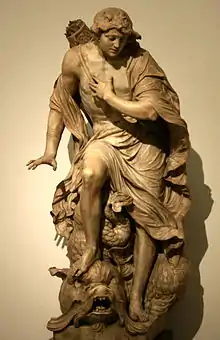Gabriël Grupello
Gabriël Grupello (also Gabriël de Grupello or Gabriël Reppeli; 22 May 1644 – 20 June 1730) was a Flemish Baroque sculptor who produced religious and mythological sculptures, portraits and public sculptures. He was a virtuoso sculptor who enjoyed the patronage of several European rulers.
Gabriël Grupello | |
|---|---|
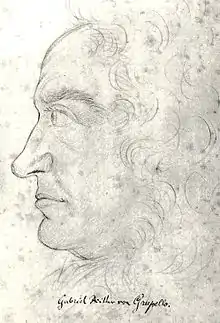 Self-portrait, c. 1700, Museum Kunstpalast, Düsseldorf | |
| Born | 22 May 1644 |
| Died | 20 June 1730 (aged 86) |
| Other names | de Grupello, Gabriël and Reppeli, Gabriël |
| Occupation | sculptor |
Life
Early life and training
Grupello was born as the son of Bernardo Rupelli, an Italian cavalry captain in Spanish service, and his Flemish wife Cornelia Delinck.[1] His father, who died at a young age, was a member of the higher non-aristocratic class of society. Grupello later styled himself as Chevalier de Grupello, but a noble ancestry has not been demonstrated.
At age 14, he started a five-year training as a sculptor in the Antwerp workshop of leading Baroque sculptor Artus Quellinus I. He may have assisted Quellinus with the sculptural decorations in the Royal Palace of Amsterdam.[2] He completed a further two years of study in Paris and Versailles, where he was in contact with his compatriots Philippe de Buyster, Gerard van Opstal and Martin Desjardins and learned the technique of bronze casting. He subsequently worked for two years for the sculptor Johan Larson in The Hague.[1]
In Brussels
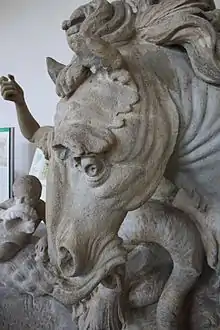
He returned to Flanders in 1671 and two years later he became a master of the Brussels Guild. He opened a workshop in Brussels, which became very successful and employed many assistants. He enjoyed the patronage of the city as well as that of various European rulers, including the Spanish king Charles II, William II of Orange and Frederick III, the Elector of Brandenburg.[2]
During his time in Brussels, he also fathered a son (born 1671) and a daughter (born 1674) with his mistress Johanna Louisa Quebault (Tebout).[1]
In Germany
In 1695, the Elector Johann Wilhelm appointed Grupello as his official court sculptor and Grupello then moved to live and work in Düsseldorf. He created numerous sculptures of the royal couple in marble and bronze, and was responsible for the supervision of craftsmen who worked on the Elector's palaces. Grupello also designed a fountain known as the Grupello pyramid for the Galerieplatz in Düsseldorf (now in Mannheim).
Grupello married Anna Maria Dautzenberg, the daughter of the Elector's lawyer, in 1698. Five children were born from this marriage.[1] The Elector gave Grupello in 1708 a house in the city centre.[3] The house, which is still called the Grupello-Haus or "Grupello House", is believed to have been designed by the Italian architect Matteo Alberti. Grupello carried out an important reconstruction of the building and used the house as the living quarters of his family and partially also as a studio. Originally, two busts representing the Greek goddesses Artemis and Aphrodite presumed to be by Grupello were placed above the portal of the house. The original bronze statues are now in the local Stadtmuseum Landeshauptstadt Düsseldorf and have been replaced by two concrete cast replicas.[4]
With the death of Elector Johann Wilhelm in 1716, the employment of the sculptor at the court came to an end. Elector Johann Wilhelm's successor Elector Carl Philipp introduced austerity measures and dismissed officials and artists. Grupello continued to live in Düsseldorf and in 1619 the Holy Roman Emperor Charles VI appointed him as Imperial sculptor.
In 1725, Grupello and his wife moved into the quarters at Ehrenstein Castle in Kerkrade (now in the Netherlands) of their daughter, who was married to an imperial official. He died there in 1730 at the age of 86 years.[1]
Work
Grupello was a versatile artist in terms of the subject range of his sculptures as well as the materials in which he worked. He executed works in marble, ivory and wood and was rare among his contemporary Flemish Baroque sculptors in that he also made bronze statues. A prime example is the bronze equestrian statue of the Elector Johann Wilhelm.
His early work shows a classicist tendency, which may be due to his study period in France. In Brussels, his work was influenced by the Flemish Baroque, and in particular Peter Paul Rubens, and developed into a full-blown Baroque style.[1] A major work that Grupello created in this style in Brussels is the marble wall fountain, intended for the main ballroom of the wholesale fishmongers guild. It is this Baroque style that he brought to Düsseldorf when he moved there. In his later life, he turned more to religious art and produced crucifixes, Madonnas and statues of saints.[1][2]
Gallery
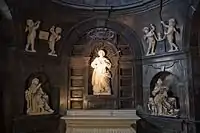 Grupello's Verwachting in de Zavelkerk, rechts van Duquesnoy's Heilige Ursula
Grupello's Verwachting in de Zavelkerk, rechts van Duquesnoy's Heilige Ursula Gabriël Grupello, Mother of God, c. 1725, linden wood. Museum Schnütgen, Cologne
Gabriël Grupello, Mother of God, c. 1725, linden wood. Museum Schnütgen, Cologne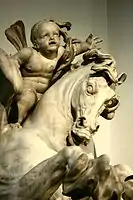 Muurfontein met zeegoden, detail
Muurfontein met zeegoden, detail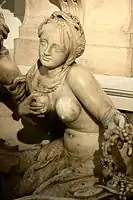 Muurfontein met zeegoden, Tethys
Muurfontein met zeegoden, Tethys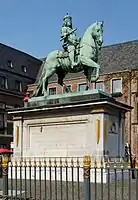 Ruiterstandbeeld in Düsseldorf
Ruiterstandbeeld in Düsseldorf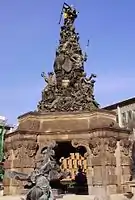 Grupellopiramide te Mannheim
Grupellopiramide te Mannheim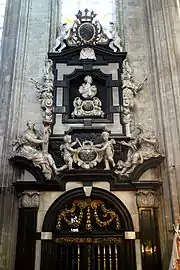 Onze-Lieve-Vrouw ten Zavelkzek, Brussel (België). Portaal van de Heilige Ursulakapel (1651-1676). Beelden door Grupello
Onze-Lieve-Vrouw ten Zavelkzek, Brussel (België). Portaal van de Heilige Ursulakapel (1651-1676). Beelden door Grupello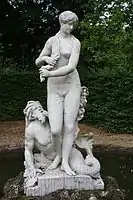 Galathea (um 1715) von Gabriel de Grupello
Galathea (um 1715) von Gabriel de Grupello
References
- C. J. A. Genders, Gabriël Grupello, in: Nationaal Biografisch Woordenboek, Volume 6, p. 392–404, Brussel, Paleis der Akademiën, 1964 (in Dutch)
- Kai Budde. "Grupello, Gabriel." Grove Art Online. Oxford Art Online. Oxford University Press. Web. 28 February 2014
- Grupellohaus Archived 4 March 2016 at the Wayback Machine (in German)
- Zwei Büsten vervollständigen wieder das Portal am Grupello-Haus (in German)
Further reading
- Rudi Dorsch: Grupello-Pyramide im neuen Glanz. Mannheim 1993.
- Udo Kultermann: Gabriel Grupello. Berlin 1968.
External links
 Media related to Gabriel de Grupello at Wikimedia Commons
Media related to Gabriel de Grupello at Wikimedia Commons
